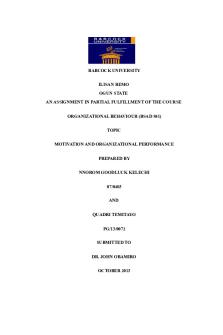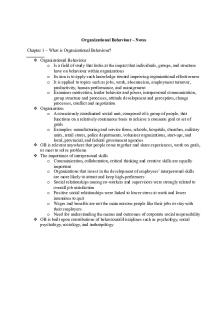Topic ONE. Introduction to Organizational Behaviour PDF

| Title | Topic ONE. Introduction to Organizational Behaviour |
|---|---|
| Author | kamau michael |
| Course | Purchasing and supplies |
| Institution | Mount Kenya University |
| Pages | 18 |
| File Size | 306.8 KB |
| File Type | |
| Total Downloads | 22 |
| Total Views | 148 |
Summary
Download Topic ONE. Introduction to Organizational Behaviour PDF
Description
TOPI CONE
1 . 1I nt r oduc t i ont oOr g ani z at i onalbe havi our 1. 1 . 1 De fini t i o no fk e yt e r ms Definition of terms Organization behaviour is concerned with the studies of behaviour of people within an organization/setting. It involves the understanding predictor is control of that behaviour. Organization behavior can thus be defined as the study and understanding of individual and group behaviour and patterns of structure in order to help in group organization performance effectively. Organization behaviour applies the knowledge gained about individuals’ groups and the effects of structure on behaviour in order to make organization more effective. Its concerned with what people do in an organization and how that behaviour affects performance of the organization it emphasizes behaviour and related to jobs work absenteeism employment turnover productivity human performance and management. Definition: Organisations comprise two or more people engaged in a systematic and coordinated effort, persistently over a period of time, in pursuit of goals which convert resources into goods and/or services which are needed by consumers. 1 . 1 . 2 Th ena t ur e& c o nt e x to fo r g a ni z a t i o ns Nature of organizational behavior Organization behavior is emerging as a separate field of study. Therefore, its nature is likely to change over the period of time. However, its present nature can be identified as follows: 1. A field of study and not a discipline. Organization behavior can be treated as a distinct field of study and not a discipline or even an emerging discipline. A discipline is an accepted science with a theoretical foundation that serves as the basis for research and analysis. Organization behavior, 1
because of its broad base, recent emergence, and interdisciplinary is not accepted as a science. 2.Interdisciplinary approach. Organization behavior is basically an interdisciplinary approach. An interdisciplinary approach integrates the relevant knowledge drawn from different disciplines for some specific purpose. Organization behavior draws heavily from psychology, sociology, and anthropology. Besides, it also takes relevant economics, political science, law and history. These disciplines exist separately, but organization behavior integrates the relevant contents of these disciplines to make them applicable organizational analysis. 3. An Applied Science. The basic objective of organization behavior is to make application of various researches to solve the organizational problems, particularly related to human behavior aspect. Unlike the pure science, which concentrates on fundamental researches, organization behavior concentrates on applied researches. Though many of the researches may be carried out in laboratory situations and controlled conditions, they are meant for application in organizational analysis. Thus organization behavior is both a science as well as an art. 4. Normative and Value Centered. Organization behavior is a normative science. A normative science, unlike the positive science, which suggests only causeeffect relationships, prescribes how the various findings of the researches can be applied to get organizational results, which are acceptable to the society. Thus, what is acceptable by the society or individuals engaged in an organization is a matter of values to 2
the people concerned. This fact cannot be explained by positive science. The normative nature of organization behavior is understood by the proliferation of theories about management styles. Ranging from "how - to" prescriptions to polemics about change in basic practices. 5. Humanistic and Optimistic. Organization behavior focuses the attention on people from humanistic point of view. It is based on the belief that needs and motivation of people are of high concern. There is an acceptance of the value of the individual as thinking, feeling organism and without these considerations the organization may not be fully operational as a social entity. Further, there is optimism about the innate potential of man to be independent, creative, productive and capable of contributing positively to the objectives of the organization. The man will actualize these potentials if given to him under proper conditions and environments. 6. Oriented Towards Organizational Objectives. Organization behavior being an applied science and emphasizing human aspect of the organization is oriented towards organizational objectives. Though an organization may have several objectives and sometimes conflicting with individual objectives, it should not be understood that organization behavior only ‘emphasizes the achievement of individual objectives at the cost of organizational objectives. In fact, organization behavior tries to integrate both types of objectives so that these are achieved simultaneously. For this, it proposes various behavioral approaches. 1 . 1 . 3Ch a r a c t e r i s t i c so f a no r g a ni z a t i o n Common Characteristics of Organizations
3
They are composed of individuals and groups; an organisation is, essentially, a social entity. It involves two or more people – but the actual number and the way in which they are organised into groups vary from one organisation to another. They exist in order to try to achieve certain goals; Organisations can be distinguished from other social groupings by virtue of the fact that they exist to achieve certain goals. They involve specialisation, and require rational co-ordination and control; Organisation involves specialisation and requires coordination. The activities of people are organised into specialised groupings. Labour is divided up in ways that are believed likely to facilitate the achievement of organisational goals. They have some degree of permanence. Organisations have some degree of permanence, in the sense that they usually have more than a momentary existence – or, even, an existence tied to the achievement of one objective. 1 . 1 . 4 Cl a s s fic a t i o no fo r g a ni z a t i o ns f o r ma l&i nf o r ma l Classification of Organization The organization can be classified on the basis of authority and responsibility assigned to the personnel and the relationship with each other. In this way, an organization can be either formal organization or informal organization. Both formal organization and informal organization are explained below. (a) Formal Organization Features of Formal organization The main features of formal organization are presented below: 1. Formal organization is consciously designed. 2. It provides for specialization. 3. It is based on delegation of authority. 4
4. The authority, responsibility, duties, policies and rules are properly well defined. 5. The principle of unity of command is usually observed. 6. It is deliberately impersonal. 7. It is supported by organization chart. Merits of Formal Organization The merits of formal organization are briefly described below: 1. There is no conflict among the employees since their respective duties and responsibilities are clearly defined. 2. Overlapping of responsibility is easily avoided. 3. It results in the motivation of employees. 4. There is no personal bias since clear cut rules and regulations are framed and followed. 5. It makes the organization less dependent on one man. Demerits of Formal Organization The followings are the demerits of formal organization. 1. It reduces the spirit of initiative. 2. There is a delay in taking a decision since rules and regulations are getting importance than situation. 3. It does not give any importance to sentiments and values of employees. 4. It reduces the free flow of communication.
5
5. It creates the problems of co-ordination. (b) Informal Organization Features of Informal Organization The features of informal organization are given below: 1. An informal organization arises spontaneously. 2. It is based on personal attitudes, emotions and likes and dislikes. 3. It provides social satisfaction to its members. 4. It is an integral part of a total organization and the management cannot eliminate it. 5. It has no place in the formal chart. 6. It is a network of personal and social relations. 7. It has its own rules and traditions. 8. It is indefinite and has no structure. Merits of Informal Organization The followings are the merits of informal organization. 1. The informal organization overcomes deficiency and fills up the gaps of the formal organization. 2. The flow of communication is very fast. 3. The motivation of employees is very easy. 4. Decisions are taken very quickly. Demerits of Informal Organization The demerits of informal organization are presented below. 6
1. It ruins the morality among the employees. 2. It acts according to mob psychology. 3. There is no evidence available for the information received under informal organization. 4. It spreads rumor among the employees regarding the attitude or approach of top management unnecessarily. 1 . 1 . 5Or g a ni z a t i o na lg o a l s Organizational Goals Organizational goals are strategic objectives that a company's management establishes to outline expected outcomes and guide employees' efforts. There are many advantages to establishing organizational goals: They guide employee efforts, justify a company's activities and existence, define performance standards, provide constraints for pursuing unnecessary goals and function as behavioral incentives. For the goals to have business merit, organizations must craft a strategic plan for choosing and meeting them. -Importance of organizational goals Goals help define a company's purpose, assist its business growth and achieve its financial objectives. Setting specific organizational goals can also help a company measure their organization's progress and determine the tasks that must be improved to meet those business goals. Goals need to be specific, measurable, achievable and timely. By setting clear, realistic goals, organizations have a clearer path to achieve success and realize its vision. Goal setting, and attaining them, can also help an organization achieve increased efficiency, productivity and profitability. 7
Organizations should clearly communicate organizational goals to engage employees in their work and achieve the organization's desired ends. Having a clear idea of organizational goals helps employees determine their course of action to help the business achieve those goals. Employees should also be equipped with the proper tools and resources needed as they do their work to help meet the overall organizational goals. Setting goals can also help companies evaluate employee performancefor example, creating individual employee goals that support overall organizational goals and measuring individual performance against those individual goals. While an organization can communicate its organizational goals through formal channels, the most effective and direct way to do so is through employees' direct supervisors. This enables managers to work with their staff to develop SMART (specific, measurable, achievable, realistic and time-bound) goals that align with the organization's goals. Setting organizational goals also helps build workplace harmony because it makes employees work toward attaining similar goals. While developing sound goals helps organizations with planning, over time, goals might turn out to be unrealistic and need to be modified accordingly. 1 . 1 . 6Or g a ni z a t i o na le nv i r o nme nt s ( PESTEL&SWOT) Organizational Environment An organization’s environment is classified as external and internal. The organization works within the framework provided by the various elements of society. All such elements lie outside the organization and are called external environment or simply as environment. Environment includes all the conditions, circumstances and influences surrounding and affecting the total organization or any of its part.
8
Environmental Factors (PESTEL) which stands for:
P – Political E – Economic S – Social T – Technological E – Environmental L – Legal
Political Factors These are all about how and to what degree a government intervenes in the economy. This can include – government policy, political stability or instability in overseas markets, foreign trade policy, tax policy, labour law, environmental law, trade restrictions and so on. Organisations need to be able to respond to the current and anticipated future legislation, and adjust their marketing policy accordingly. Economic Factors Economic factors have a significant impact on how an organisation does business and also how profitable they are. Factors include – economic growth, interest rates, exchange rates, inflation, disposable income of consumers and businesses and so on. These factors can be further broken down into macro-economical and micro-economical factors. Macro-economical factors deal with the management of demand in any given economy. Governments use interest rate control, taxation policy and government expenditure as their main mechanisms they use for this. Micro-economic factors are all about the way people spend their incomes. This has a large impact on B2C organisations in particular. Social Factors Also known as socio-cultural factors, are the areas that involve the shared belief and attitudes of the population. These factors include – population growth, age distribution, health consciousness, career attitudes and so on. These factors are of particular interest as they have a 9
direct effect on how marketers understand customers and what drives them. Technological Factors Currently we know how fast the technological landscape changes and how this impacts the way we market our products. Technological factors affect marketing and the management thereof in three distinct ways: New ways of producing goods and services New ways of distributing goods and services New ways of communicating with target markets Environmental Factors These factors have become important due to the increasing scarcity of raw materials, pollution targets, doing business as an ethical and sustainable company, carbon footprint targets set by governments (this is a good example were one factor could be classes as political and environmental at the same time). These are just some of the issues marketers are facing within this factor. More and more consumers are demanding that the products they buy are sourced ethically, and if possible from a sustainable source. Legal Factors Legal factors include - health and safety, equal opportunities, advertising standards, consumer rights and laws, product labelling and product safety. It is clear that companies need to know what is and what is not legal in order to trade successfully. If an organisation trades globally this becomes a very tricky area to get right as each country has its own set of rules and regulations. SWOT ANALYSIS: which stands for:
S – Strenghts W – Weaknesses O – Oppurtunities 10
T – Threats
Strengths (Internal factor / Positive influence) What are we best at? What intellectual property do we own that can help us with this objective? What specific skills does the current workforce have that can contribute to this objective? What financial resources do we have for reaching this objective? What connections and alliances do we have? What is our bargaining power with both suppliers and intermediaries? Opportunities (External factor / Positive influence) What changes in the external environment can we exploit? What weaknesses in our competitors can we use to our advantage? What new technology might become available to us? What new markets might be opening to us? Weaknesses (Internal factor / Negative influence) What are we worst at doing? Is our intellectual property outdated? What training does our workforce lack? What is our financial position? What connections and alliances should we have, but don’t? Threats (External factors / Negative influence) What might our competitors be able to do to hurt us? What new legislation might damage our interests? What social changes might threaten us? How will the economic cycle affect us? 1 . 2
Bac kgr oundofOr g ani z at i onalbe havi our 11
1 . 2 . 1Co nt r i b ut i o nso fb e h a vi o ur a ls c i e nc e st oOr g a ni s a t i o na l b e h a vi o ur Importance of behavioural sciences Enables managers to understand and predict behaviour in the workplace and sometimes attempt to change the behaviour. Helps to satisfy the innate drive to make sense of what is happening around us OB theories give the opportunity to question and rebuild personal mental models that have developed through observation and experience. OB concepts help to influence people, perform the job better and work more effectively with others. Organizations achieve better financial success where OB concepts such as performance management, employee communication and work-life balance are applied. OB practices translate to favourable employee attitudes. It encompasses the disciplines of psychology, sociology, social psychology, anthropology and political science. By this, we seek to measure, explain, try to understand individual behaviour and sometimes attempt to change the behaviour. In employment learning, perception, personality, emotions, training, leadership effectiveness, needs and motivational forces, job satisfaction, decision-making processes and work stress are important in understanding behaviour. In social terms, it is an approach to people in relationship with others. It helps in understanding group working, communication, silent listening etc., Anthropology helps to know the basic attitudinal factors based on earlier societies. 1 . 2 . 2Le v e l so fa na l y s i so fo r g ni z a t i o na lb e h a v i o ur I nd i v i d ua l Theg r o up 12
Theo r g a ni z a t i o n Levels of analysing organizational behaviour The individual is the central feature of organizational behaviour and a necessary part of any situation in response to expectations of the organization or as a result of the influence of the external environment. Groups exist in all organizations and are essential to their working and performance. An understanding of group structure and behaviour complements knowledge of individual behaviour and adds a further dimension to organizational behaviour. The organization. Structure is created by management to establish relationship between individuals and groups, to provide order and systems and to direct the efforts of the organization into goal seeking activities. Behaviour is affected by patterns of organizational structure, technology, styles of leadership and systems of management through which organizational process are planned, directed, and controlled. The focus of attention is on the impact of organization structure and design and patterns of management, on the behaviour of people within the organization. The environment The organization functions as part of the broader external environment of which it is part. The effects of the operation of the organization within its environment are reflected in terms of the management of opportunities and risks and the successful achievement of its aims and objectives. The following factors might be identified as impacting on the organisation: a) political – factors affecting the requirements placed on organisations arising from the actions of national (and international) governments and governmental agencies, including legislation, and the general political dimension which issues and activities may assume; b) economic – factors affecting the financial functioning of the organisation such as the potential for growth or for 13
retrenchment in the economy at large in relation to the market for the organisation's products, or the value of money as it impacts on reward systems; c) social – factors affecting the supply of labour, such as demographic changes in terms of the age profile of the working population, numbers of people in the job market, etc., and changing cultural norms of behaviour and attitudes in society at large which in...
Similar Free PDFs

Topic One - Introduction Canvas
- 28 Pages
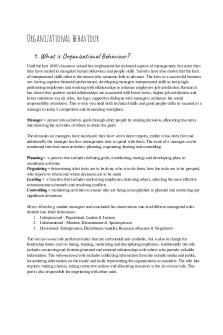
Organizational behaviour
- 67 Pages

Organizational Behaviour
- 2 Pages
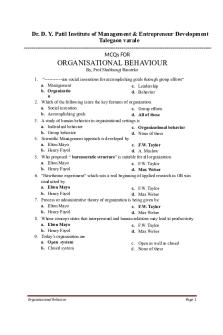
Organizational Behaviour mcqs
- 27 Pages
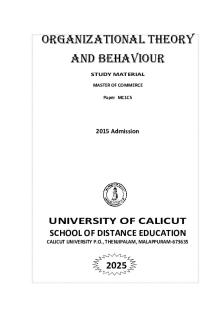
Organizational theory and behaviour
- 186 Pages
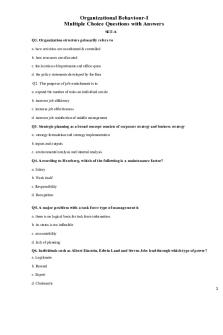
Organizational Behaviour MCQ SET
- 20 Pages
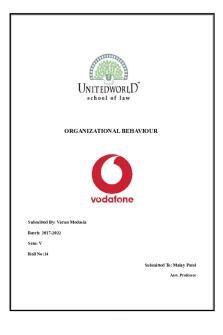
Organizational Behaviour Project
- 15 Pages

Chapter 2 ORGANIZATIONAL BEHAVIOUR
- 23 Pages
Popular Institutions
- Tinajero National High School - Annex
- Politeknik Caltex Riau
- Yokohama City University
- SGT University
- University of Al-Qadisiyah
- Divine Word College of Vigan
- Techniek College Rotterdam
- Universidade de Santiago
- Universiti Teknologi MARA Cawangan Johor Kampus Pasir Gudang
- Poltekkes Kemenkes Yogyakarta
- Baguio City National High School
- Colegio san marcos
- preparatoria uno
- Centro de Bachillerato Tecnológico Industrial y de Servicios No. 107
- Dalian Maritime University
- Quang Trung Secondary School
- Colegio Tecnológico en Informática
- Corporación Regional de Educación Superior
- Grupo CEDVA
- Dar Al Uloom University
- Centro de Estudios Preuniversitarios de la Universidad Nacional de Ingeniería
- 上智大学
- Aakash International School, Nuna Majara
- San Felipe Neri Catholic School
- Kang Chiao International School - New Taipei City
- Misamis Occidental National High School
- Institución Educativa Escuela Normal Juan Ladrilleros
- Kolehiyo ng Pantukan
- Batanes State College
- Instituto Continental
- Sekolah Menengah Kejuruan Kesehatan Kaltara (Tarakan)
- Colegio de La Inmaculada Concepcion - Cebu





